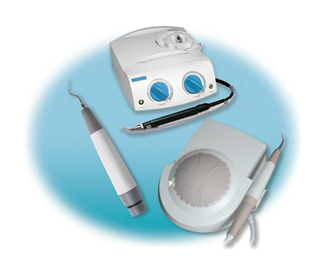A myriad of new products have been introduced that have revolutionized periodontal therapy in the past several years. Many of the recognized brand names have survived the test of time, offering the benefit of reducing hand and wrist fatigue as well as tissue trauma. Common in today’s hygiene and periodontal armamentarium is the sonic or ultrasonic handpiece. Whether used only occasionally or on a routine basis, most dental professionals are familiar with sonic or ultrasonic technology in some capacity. With the utility of the products that are available today, there is no reason why every operatory should not be equipped with this technology.
The sonic scaler operates at a low frequency of about 3,000 to 8,000 cycles/second (which is how many times the tip comes in contact with the tooth). The sonic scaler is air-driven, and the tip moves in an elliptical motion. The ultrasonic handpiece utilizes either magnetostrictive or piezo-electric technology. Magnetostrictive inserts operate at 25,000 to 30,000 cycles/second and, like the sonic scaler, have an elliptical motion. A low-voltage magnetic signal causes tip movement. Piezo-electric technology operates at 28,000 to 36,000 cycles/second. The tip moves in a back-and-forth motion and works along the side of the tooth, shaving off calculus and debris. Here the handpiece, rather than the instrument tip, is activated.
The use of ultrasonic devices has dramatically improved the practice of supragingival scaling and periodontal debridement. Although ultrasonic technology has been around for decades, improvements in recent years have allowed its use to become mainstream. Ultrasonic technology in general, whether magnetostrictive (long inserts with metal rods that flex) or piezo-electric (small tips that screw onto the handpiece), and sonic scalers to a lesser degree, offer several advantages over hand scaling:
 |
|
Lower right photo courtesy of Raymond J. Voller, DMD.
Digital modifications by Cheryl Gloss. |
(1) less hand and wrist fatigue due to the light touch necessary to merely guide the scaler tip along the tooth surface
(2) decreased treatment time, especially with heavy deposits, leaving more time for patient education or procedures such as placement of chemotherapeutic agents (ie, Arestin [OraPharma], Atridox [Collagenex Pharmaceuticals], or PerioChip [Dexcel Pharma]).
(3) more efficient removal of dental plaque and calculi with ultrasonic instrumentation
(4) ultrasonic tip spray promotes elimination of dental plaque
(5) ultrasonic instruments rid the radicular surfaces of bacterial endotoxins while preserving the cementum
(6) less tissue trauma due to no sharp cutting edges
(7) water provides continuous tissue lavage, thereby reducing the need for rinsing during scaling, since the water flow allows for high visibility throughout the procedure; this lavage also increases tissue comfort for the patient during and after the procedure
(8) antiseptic solution can be substituted for the water to provide simultaneous irrigation/disinfection of the region being treated
(9) excellent for stain removal that may otherwise be tedious to scale by hand
(10) gritty, pumice-based polish may no longer be necessary or indicated following scaling with ultrasonic; due to the efficient stain removal during scaling, a milder, minimally invasive paste or polish can be used, preserving the glaze on composite and porcelain restorations; less abrasive polish enhances patient acceptance and lowers post-scaling sensitivity
(11) less chance of operator injury:
•ultrasonic scaler inserts are not sharp—there are no cutting edges
•seldom need to place tips in an ultrasonic bath prior to sterilization, eliminating a step in the handling process
•rarely need to scrub ultrasonic tips, as is often necessary for conventional hand scalers, further reducing the risk of operator injury
•hand instrument sharpening greatly minimized due to minimal usage
(12) patients experience a higher level of comfort; the entire procedure is endured more easily.
PIEZO-ELECTRIC TECHNOLOGY
With piezo-electric technology, achieving ultrasonic mechanical vibration requires the application of an electrical voltage to piezo-electric ceramics. The ultrasonic energy thus generated is transmitted via a transducer contained in the handpiece and is prolonged by an amplifier. The resulting advantages of this mechanism include enhanced power control, greater patient convenience, and high transducer efficiency. The axial transmission mode of mechanical waves allows a more accurate approach to fragile tissues. Furthermore, there is no cumbersome cooling system necessary.
Piezo-electric scalers in particular have some distinct advantages over many other conventional ultrasonic units. In addition to the previously mentioned benefits of ultrasonics in general, piezo-electric technology offers the following:
(1) quiet operation
(2) less water is necessary during the procedure, adding to patient comfort and operator convenience; less need for management of excessive water accumulation; less water is required because the unit’s efficiency is greater than 90%—there is no delivered energy or mechanical friction, hence, little secondary temperature rise; since there is very little temperature rise, the handpiece can be used without water. (However, use of light water spray may be desirable, as this will produce a cavitation or physico-chemical effect.)
(3) less vibration
(4) small inserts—less cum-bersome to operate, more accurate placement during treatment, increasing patient comfort
(5) versatile ultrasonic units have numerous clinical applications due to a comprehensive range of accessories; in addition to inserts for use in scaling and debridement, many other inserts are available for procedures such as periodontics, apical surgery, and prosthodontics; dozens of various inserts are offered that all fit on the same handpiece
(6) LED curing light is available with some units—much more convenient to assemble and operate than conventional curing lights, saving time, money, and space; the light simply attaches to the unit in place of the piezo-electric handpiece; perfect for sealant curing in the hygiene room as well as for restorative materials
(7) lightweight handpiece and hose; easy on the wrist
(8) can be used for virtually any class of patient; great for routine prophylactic procedures as well as periodontal scaling and root planing; a wide range of convenient, thin insert designs for all possible scenarios
(9) small unit sits on counter; small footprint
(10) convenient, color-coded power dial on some units—coordinates with colored rings on inserts; no guessing at the ideal power setting for each insert, as is sometimes the case with other ultrasonic handpieces
(11) inserts for piezo-electric units are often interchangeable with other manufacturers
(12) easy, convenient barrier protection—intraoral camera sheaths intimately fit many piezo-electric handpieces; barrier protection for the unit itself is provided by simply placing a sheet of plastic wrap loosely over the entire unit; with this in place, the operator can adjust the water and power setting and place the handpiece in its holder without contaminating the unit, which minimizes the use of surface disinfectant, which would add time following the procedure and risk damaging the unit
(13) handpiece and inserts are easily removable and autoclavable
(14) piezo-electric inserts take up much less space to store than hand scalers and other dental instruments
(15) the use of state-of-the-art technology helps to strengthen patient relations; communicating with patients and educating them about the advantages of the piezo-electric scaler is a practice builder; patients feel more comfortable throughout the procedure and confident that they are receiving the best possible care.
CONCLUSION
The piezo-electric scaler is a staple in our hygiene rooms. Hygienists in our office rave about our new piezo-electric scalers and, more importantly, patients are very complimentary about how their mouths feel after their maintenance visits. If you have the desire to move into the world of electric scalers, or are ready to upgrade, give considerable thought to the purchase of a piezo-electric scaler. This technology will stand the test of time. It is the ultimate in ultrasonic scalers.
Acknowledgment
The author would like to thank Anna R. Voller, RDH, and Kierstin Bowser, RDH, for their assistance, input, and support with the preparation of this article.
References
1. Drisko CL, Cochran DL, Blieden T, et al; Research, Science and Therapy Committee of the American Academy of Periodontology. Position paper: sonic and ultrasonic scalers in periodontics. J Periodontol. 2000;71:1792-1801.
2. CRA Newsletter. Issue 10, 2003;27.
Dr. Voller maintains a private practice in Kittanning, Pa, that focuses on aesthetic and reconstructive dentistry and orthodontics. He is a clinical in-structor in dental digital photography and is on the advisory board of directors of GenR8Tnext.com, The Academy of Comprehensive Esthetics. Dr. Voller lectures nationally and has published several articles on full-mouth reconstruction and aesthetic dentistry. He can be reached at (724) 543-4948 and (724) 664-5960, at drvoller.com, or by visiting vollersmiles.com.











